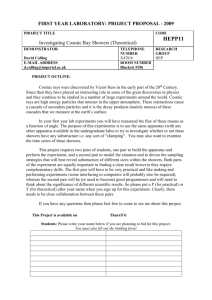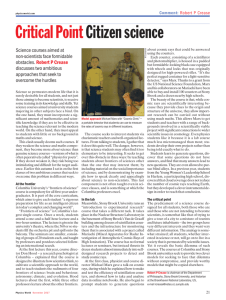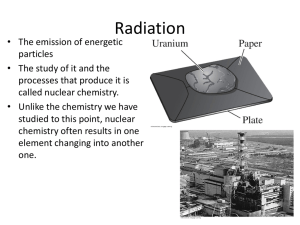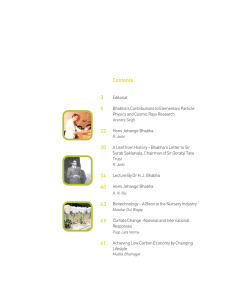international project - internationalfriends
advertisement
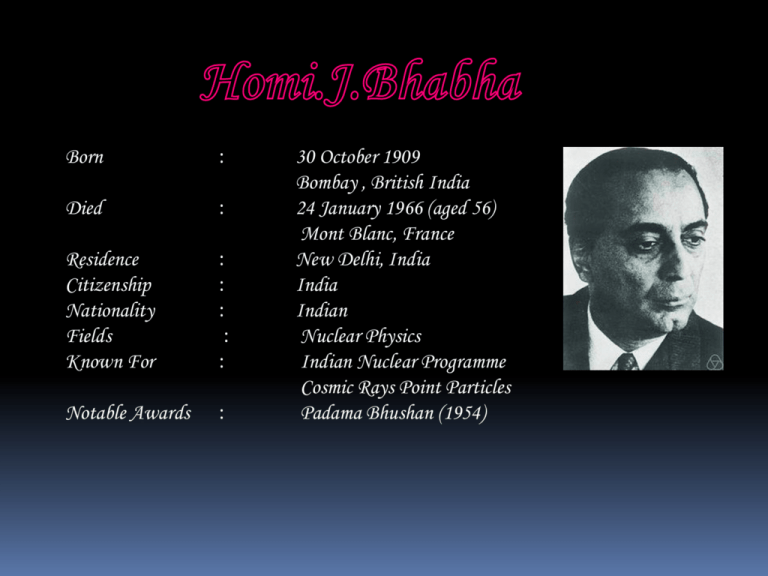
Born : Died : Residence Citizenship Nationality Fields Known For : : : : : Notable Awards : 30 October 1909 Bombay , British India 24 January 1966 (aged 56) Mont Blanc, France New Delhi, India India Indian Nuclear Physics Indian Nuclear Programme Cosmic Rays Point Particles Padama Bhushan (1954) •Homi Jehangir Bhabha was born into a wealthy and prominent industrial parsi family, through which Tata Tata he was related to Dinshaw Maneckji Petit, and Dorabji Tata. His name, Jahangir (Jehangir), is from Persian , meaning “conqueror of the world. •He was been educated at : UNIVERSITY OF CAMBRIDGE ELPHINSTONE COLLEGE INSTITUTE OF SCIENCE GONIRLLE AND CAIUS COLLEGE,CAMBRIDGE HOMI J. BHABHA •HOMI JEHANGIR BHABHA, was an Indian nuclear physicist, founding director, and professor of physics at the Tata Institute of Fundamental Research. • Bhabha was the founding director of two well-known research institutions, namely the Tata Institute of Fundamental Research (TIFR) and the Trombay Atomic Energy Establishmen. •As he started his scientific career in nuclear physics from great Britain ,he returned to India for his annual vacation prior to start of the world war II in September 1939. •During his time Bhabha played a key role in convincing the congress party’s senior leaders ,most notable Jawaharalal Nehru who later served India’s first premiere, to start the ambitious nuclear program •In January 1936, Bhabha received his doctorate in nuclear physics after publishing his scientific paper,’’ The Absorption of Cosmic radiation ‘’. In the publication, Bhabha offered an explanation of the absorption features and electron shower production in cosmic rays. The paper helped him win the Isaac Newton studentship in 1934, which he held for the next three years •In 1936, the two published a paper, “The Passage of Fast Electrons and the Theory of Cosmic Showers” in the Proceeding of the Royal Society, Series A, in which they used their theory to describe how primary cosmic rays from outer space interact with the upper atmosphere to produce particles observed at the ground level •In September 1939 , Bhabha was in India for a brief holiday when World War II broke out, and he decided not to return to England for the time being. • He accepted an offer to serve as the Reader in the Physics Department of the Indian Institute of Science, then headed by renowned physicist C.V. Raman. He received a special research grant from the Sir Dorab Tata Trust, which he used to establish the Cosmic Ray Research Unit at the institute . • Bhabha selected a few students, including Harish-Chandra, to work with him. Later, on 20 March 1941, he was elected a Fellow of the Royal Society. With the help of J. R. D. Tata, he played an instrumental role in the establishment of the Tata Institute of Fundamental Research in Bombay.” When Bhabha was working at the Indian Institute of Science, there was no institute in India which had the necessary facilities for original work in nuclear physics, cosmic rays, high energy physic, and other frontiers of knowledge in physics. This prompted him to send a proposal in March 1944 to the Sir Dorabji Jamsetji Tata. Tata Trust for establishing ‘a vigorous school of research in fundamental physics’. In his proposal he wrote: When nuclear energy has been successfully applied for power production in say couple of decays from now, India will not have to look abroad for its experts but will find them ready at hand. I do not think at hand. I do not think that anyone acquainted with scientific development in other countries would deny the need in India for such a schools as I propose. The subjects on which research and advanced teaching would be done would be theoretical physics, especially on fundamental problems and with special reference to cosmic rays and nuclear physics, and experimental research on cosmic rays. It is neither possible nor desirable to separate nuclear physics from cosmic rays since the two are closely connected theoretically. The trustees of Sir Dorbaji Jamsetji Tata Trust decided to accept Bhabha’s proposal & financial responsibility for starting the Institute in April 1944. When nuclear energy has been successfully applied for power production in say couple of decays from now, India will not have to look abroad for its experts but will find them ready at hand. I do not think at hand. I do not think that anyone acquainted with scientific development in other countries would deny the need in India for such a schools as I propose. The subjects on which research and advanced teaching would be done would be theoretical physics, especially on fundamental problems and with special reference to cosmic rays and nuclear physics, and experimental research on cosmic rays. It is neither possible nor desirable to separate nuclear physics from cosmic rays since the two are closely connected theoretically. The trustees of Sir Dorbaji Jamsetji Tata Trust decided to accept Bhabha’s proposal & financial responsibility for starting the Institute in April 1944. When nuclear energy has been successfully applied for power production in say couple of decays from now, India will not have to look abroad for its experts but will find them ready at hand. I do not think at hand. I do not think that anyone acquainted with scientific development in other countries would deny the need in India for such a schools as I propose. The subjects on which research and advanced teaching would be done would be theoretical physics, especially on fundamental problems and with special reference to cosmic rays and nuclear physics, and experimental research on cosmic rays. It is neither possible nor desirable to separate nuclear physics from cosmic rays since the two are closely connected theoretically. The trustees of Sir Dorbaji Jamsetji Tata Trust decided to accept Bhabha’s proposal & financial responsibility for starting the Institute in April 1944. When nuclear energy has been successfully applied for power production in say couple of decays from now, India will not have to look abroad for its experts but will find them ready at hand. I do not think at hand. I do not think that anyone acquainted with scientific development in other countries would deny the need in India for such a schools as I propose. The subjects on which research and advanced teaching would be done would be theoretical physics, especially on fundamental problems and with special reference to cosmic rays and nuclear physics, and experimental research on cosmic rays. It is neither possible nor desirable to separate nuclear physics from cosmic rays since the two are closely connected theoretically. The trustees of Sir Dorbaji Jamsetji Tata Trust decided to accept Bhabha’s proposal & financial responsibility for starting the Institute in April 1944. He died when AIR INDIA FLIGHT 101 crashed near Mont Blanc on January 24, 1996.Many possible theories have been advanced for the air crash, including conspiracy theory in which central intelligence agency (CIA) is involved in order to paralyze India’s nuclear program. In 2012, an Indian diplomatic bag containing newspapers, calendars and a personal letter was recovered near the crash site.
